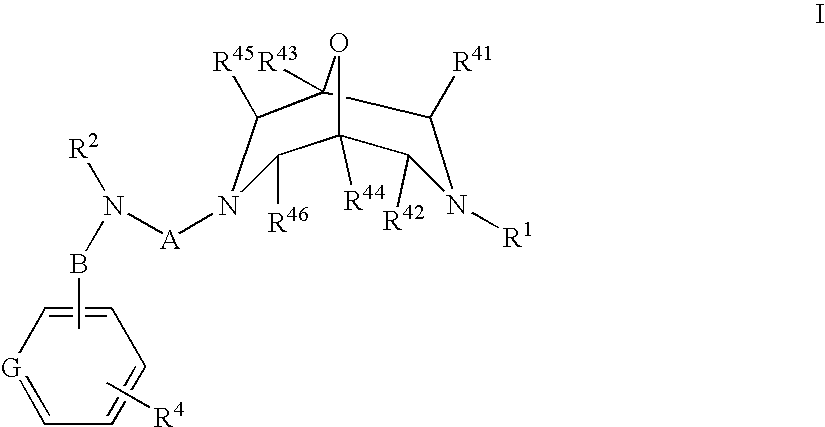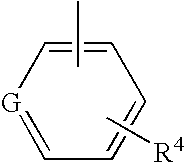Novel Oxabispidine Compounds And Their Use In The Treatment Of Cardiac Arrhythmias
a technology of oxabispidine and compound, which is applied in the field of new oxabispidine compounds and their use in the can solve the problems of (turning points), and achieve the effects of less side effects, more efficacy, and effective treatment of cardiac arrhythmias
- Summary
- Abstract
- Description
- Claims
- Application Information
AI Technical Summary
Benefits of technology
Problems solved by technology
Method used
Image
Examples
preparation b
N-[3-(4-Cyanophenyl)propyl]-N-[2-(9-oxa-3,7-diazabicyclo[3.3.1]non-3-yl)ethyl]methanesulfonamide, hydrochloride salt
(i) 7-(2-{[3-(4-Cyanophenyl)propyl]methanesulfonylamino}ethyl)-9-oxa-3,7-diazabicyclo[3.3.1]nonane-3-carboxylic acid tert-butyl ester
[0192]A mixture of 9-oxa-3,7-diaza-bicyclo[3.3.1]nonane-3-carboxylic acid tert-butyl ester (2.35 g, 0.01 mol; see WO 01 / 28992), methanesulfonic acid 2-{[3-(4-cyanophenyl)propyl]methanesulfonylamino}ethyl ester (3.7 g, 0.01 mol; see Preparation A above) and anhydrous K2CO3 (2.1 g, 0.015 mol) in dry acetonitrile (70 mL) was stirred under nitrogen atmosphere at 55-60° C. for 3 days. After filtration and concentration, the crude product was purified by column chromatography (silica gel: 60-120 mesh, eluent: petroleum ether-ethyl acetate, 50:50). Yield: 3.25 g (66%).
(ii) N-[3-(4-Cyanophenyl)propyl]-N-[2-(9-oxa-3,7-diazabicyclo[3.3.1]non-3-yl)ethyl]methanesulfonamide hydrochloride salt
[0193]7-(2-{[3-(4-cyanophenyl)propyl]methanesulfonylamino}et...
preparation d
Toluene-4-sulfonic acid 2-{1-[2-(4-cyanophenoxy)ethyl]ureido}ethyl ester
(i) N-[2-(4-Cyanophenoxy)ethyl]-N-(2-hydroxyethyl)urea
[0198]To a solution of 4-[2-(2-hydroxyethylamino)ethoxy]benzonitrile (5 g, 0.0242 mol; see Preparation C(ii) above) in dioxane (65 mL) and water (65 mL) was added, at rt, potassium cyanate (4.92 g, 0.0606 mol), followed by acetic acid (4.36 g, 0.0726 mol). The reaction mixture was then stirred at rt overnight, before being concentrated under reduced pressure. The resulting residue was partitioned between water and dichloromethane. The organic layer was separated, washed with water and brine, dried over sodium sulfate and then concentrated. The crude product was further purified by column chromatography. Yield: 3.5 g.
(ii) Toluene-4-sulfonic acid 2-{1-[2-(4-cyanophenoxy)ethyl]ureido}ethyl ester
[0199]To a solution of intermediate 1-[2-(4-cyanophenoxy)ethyl]-1-(2-hydroxyethyl)urea (4.7 g, 0.0188 mol; see step (i) above) in dry THF (150 mL) was added n-butyllithiu...
example 1
N-[2-(7-Benzyl-9-oxa-3,7-diazabicyclo[3.3.1]non-3-yl)ethyl]-N-[2-(4-cyanophenoxy)ethyl]urea
[0233]3-Benzyl-9-oxa-3,7-diaza-bicyclo[3.3.1]nonane (0.18 g, 0.82 mmol; see WO 01 / 28992) and toluene-4-sulfonic acid 2-{1-[2-(4-cyanophenoxy)ethyl]-ureido}ethyl ester (0.50 g, 1.24 mmol; see Preparation D above) were mixed in dry acetonitrile (15 mL) and stirred at 60° C. overnight. DCM (10 mL) was added, together with 0.5 g of PS—NCO (polymer-supported isocyanate). The mixture was stirred for 2 h, then filtered and evaporated. The crude product was put on a SCX-II (cat ion exchanger)-plug, which plug was then eluted with DCM:MeOH(NH3-saturated), 80:20. The product was further purified on a Horizon prep. column (40 g, A: DCM (1% MeOH), B: DCM / MeOH(NH3-sat.), 80:20. Gradient 0-30% B over 1080 mL). The product was then further purified by prep. HPLC and finally extracted with DCM / Na2CO3 (aq.) to give 193 mg (51.9%) of the title compound.
[0234]13C NMR (100.6 MHz, CDCl3) δ 162.2, 161.5, 136.2, 134...
PUM
 Login to View More
Login to View More Abstract
Description
Claims
Application Information
 Login to View More
Login to View More - R&D
- Intellectual Property
- Life Sciences
- Materials
- Tech Scout
- Unparalleled Data Quality
- Higher Quality Content
- 60% Fewer Hallucinations
Browse by: Latest US Patents, China's latest patents, Technical Efficacy Thesaurus, Application Domain, Technology Topic, Popular Technical Reports.
© 2025 PatSnap. All rights reserved.Legal|Privacy policy|Modern Slavery Act Transparency Statement|Sitemap|About US| Contact US: help@patsnap.com



